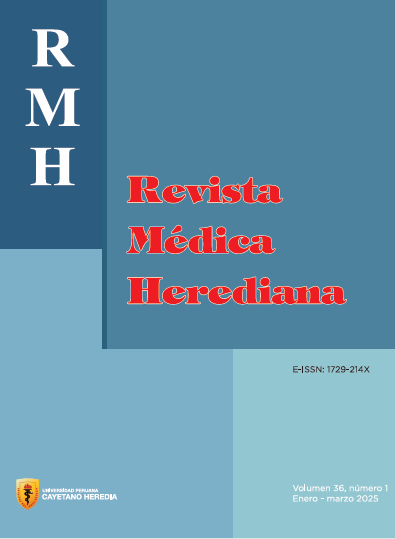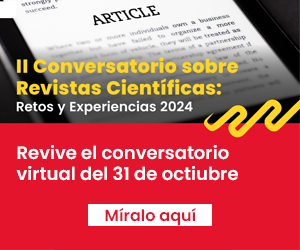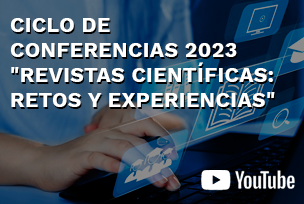Sociodemographic factors associated with cyberchondria related to COVID-19 in medical students from two Peruvian universities
DOI:
https://doi.org/10.20453/rmh.v36i3.5088Keywords:
Medical students, Sociodemographic factors, COVID-19, Internet-Based InterventionAbstract
Objectives: To examine the link between COVID-19-related cyberchondria and sociodemographic factors among medical students from two Peruvian universities. Methods: Cross-sectional observational study conducted in 345 students from two Peruvian medical schools (2020–2021) using an online questionnaire. Results: Significant differences were found by age, as cyberchondria levels decreased with increasing age. Students with family members working in health had lower scores on the “excessive” subscale. No association was found between cyberchondria and gender, marital status, or having a relative diagnosed with COVID-19. Conclusions: Cyberchondria was inversely associated with age; older participants had lower levels. Having relatives in the health field was associated with lower cyberchondria, while gender, marital status, and relatives with COVID-19 showed no relationship.
Downloads
References
Hu B, Guo H, Zhou P, Shi Z-L. Characteristics of SARS-CoV-2 and COVID-19. Nat Rev Microbiol. 2021 Mar;19(3):141–54. doi: 10.1038/s41579-020-00459-7
Lytras T, Tsiodras S. Lockdowns and the COVID-19 pandemic: What is the endgame? Scand J Public Health. 2021 Feb;49(1):37–40. doi: 10.1177/1403494820961293
Venegas-Vera AV, Colbert GB, Lerma E V. Positive and negative impact of social media in the COVID-19 era. Rev Cardiovasc Med. 2020 Dec;21(4):561–4. doi: 10.31083/j.rcm.2020.04.195
Farooq A, Laato S, Najmul Islam AKM. Impact of online information on self-isolation intention during the COVID-19 Pandemic: Cross-Sectional study. J Med Internet Res. 2020;22(5):1–15. doi: 10.2196/19128.
Yang Y, Ta N, Li Z. Investigating the Obsessive and Compulsive Features of Cyberchondria: A Holistic Review. Front Psychol. 2022;13:897426. doi: 10.3389/fpsyg.2022.897426
Mestre-Bach G, Potenza MN. Cyberchondria: a Growing Concern During the COVID-19 Pandemic and a Possible Addictive Disorder? Curr Addict Reports [Internet]. 2023;10(1):77–96. doi: 10.1007/s40429-022-00462-3
Abu Khait A, Mrayyan MT, Al-Rjoub S, Rababa M, Al-Rawashdeh S. Cyberchondria, Anxiety Sensitivity, Hypochondria, and Internet Addiction: Implications for Mental Health Professionals. Curr Psychol. 2022 Oct; Volumen?:1–12. doi: 10.1007/s12144-022-03815-3.
Vismara M, Vitella D, Biolcati R, Ambrosini F, Pirola V, Dell’Osso B, et al. The Impact of COVID-19 Pandemic on Searching for Health-Related Information and Cyberchondria on the General Population in Italy. Front psychiatry. 2021;12:754870. doi: 10.3389/fpsyt.2021.754870.
Hesse BW, Greenberg AJ, Rutten LJF. The role of Internet resources in clinical oncology: promises and challenges. Nat Rev Clin Oncol. 2016 Dec;13(12):767–76. doi: 10.1038/nrclinonc.2016.78
Schenkel SK, Jungmann SM, Gropalis M, Witthöft M. Conceptualizations of Cyberchondria and Relations to the Anxiety Spectrum: Systematic Review and Meta-analysis. J Med Internet Res. 2021 Nov;23(11):e27835. doi: 10.2196/27835.
Sohail M, Zafar N. Fear of COVID-19 and stress in university students: mediating role of cyberchondria and moderating role of creative coping and social supports. J Pak Med Assoc. 2022 Aug;72(8):1564–71. doi: 10.47391/JPMA.4350
Bajcar B, Babiak J, Olchowska-Kotala A. Cyberchondria and its measurement. The polish adaptation and psychometric properties of the cyberchondria severity scale CSS-PL. Psychiatr Pol. 2019;53(1):49–60. doi: 10.12740/PP/81799
Small GW, Lee J, Kaufman A, Jalil J, Siddarth P, Gaddipati H, et al. Brain health consequences of digital technology use. Dialogues Clin Neurosci. 2020; 22(2):179–87. doi: 10.31887/dcns.2020.22.2
Pawar P, Kamat A, Salimath G, Jacob KR, Kamath R. Prevalence of Cyberchondria among Outpatients with Metabolic Syndrome in a Tertiary Care Hospital in Southern India. ScientificWorldJournal. 2022; 2022:3211501. doi: 10.1155/2022/3211501
Serra-Negra JM, Paiva SM, Baptista AS, Cruz AJS, Pinho T, Abreu MH. Cyberchondria and Associated Factors Among Brazilian and Portuguese Dentists. Acta Odontol Latinoam. 2022 Apr;35(1):45–50. doi: 10.54589/aol.35/1/45
Kaul V, Gallo de Moraes A, Khateeb D, Greenstein Y, Winter G, Chae J, et al. Medical Education During the COVID-19 Pandemic. Chest. 2021 May;159(5):1949–60. doi: 10.1016/j.chest.2020.12.026
OpenEpi Menu. OpenEpi [Internet]. [citado el 2 de octubre de 2023]. Disponible en: https://www.openepi.com/SampleSize/SSPropor.htm
Ciułkowicz M, Misiak B, Szcześniak D, Grzebieluch J, Maciaszek J, Rymaszewska J. The Portrait of Cyberchondria-A Cross-Sectional Online Study on Factors Related to Health Anxiety and Cyberchondria in Polish Population during SARS-CoV-2 Pandemic. Int J Environ Res Public Health. 2022 Apr;19(7):páginas?. doi: 10.3390/ijerph19074347
Fergus TA. The Cyberchondria Severity Scale (CSS): an examination of structure and relations with health anxiety in a community sample. J Anxiety Disord. 2014 Aug;28(6):504–10. doi: 10.1016/j.janxdis.2014.05.006
McElroy E, Kearney M, Touhey J, Evans J, Cooke Y, Shevlin M. The CSS-12: Development and Validation of a Short-Form Version of the Cyberchondria Severity Scale. Cyberpsychol Behav Soc Netw. 2019 May;22(5):330–5. doi: 10.1089/cyber.2018.0624
Arnáez S, García-Soriano G, Castro J, Berle D, Starcevic V. The Spanish version of the short form of the Cyberchondria Severity Scale (CSS-12): Testing the factor structure and measurement invariance across genders. Curr Psychol [Internet]. 2022; 42:20686–20695. doi:10.1007/s12144-022-03170-3
Yang Y, Ta N, Li Z. Investigating the Obsessive and Compulsive Features of Cyberchondria: A Holistic Review. Front Psychol. 2022 Jul;13:897426. doi: 10.3389/fpsyg.2022.897426
Khazaal Y, Chatton A, Rochat L, Hede V, Viswasam K, Penzenstadler L, et al. Compulsive Health-Related Internet Use and Cyberchondria. Eur Addict Res. 2021;27(1):58–66. doi: 10.1159/000510922
Arsenakis S, Chatton A, Penzenstadler L, Billieux J, Berle D, Starcevic V, et al. Unveiling the relationships between cyberchondria and psychopathological symptoms. J Psychiatr Res. 2021 Feb;143:254–61. doi: 10.1016/j.jpsychires.2021.09.014
McMullan RD, Berle D, Arnáez S, Starcevic V. The relationships between health anxiety, online health information seeking, and cyberchondria: Systematic review and meta-analysis. J Affect Disord. 2019;245:270–8. doi:10.1016/j.jad.2018.11.037
Maftei A, Holman AC. Cyberchondria During the Coronavirus Pandemic: The Effects of Neuroticism and Optimism. Front Psychol. 2020;11:567345. doi: 10.3389/fpsyg.2020.567345
Starcevic V, Eslick GD, Viswasam K, Billieux J, Gainsbury SM, King DL, et al. Problematic online behaviors and psychopathology in Australia. Psychiatry Res. 2023; 327:115405. doi: 10.1016/j.psychres.2023.115405
Makarla S, Gopichandran V, Tondare D. Prevalence and correlates of cyberchondria among professionals working in the information technology sector in Chennai, India: A cross-sectional study. J Postgrad Med. 2019;65(2):87–92. doi: 10.4103/jpgm.JPGM_293_18
Downloads
Published
How to Cite
Issue
Section
License
Copyright (c) 2025 javier revilla bravo

This work is licensed under a Creative Commons Attribution 4.0 International License.
Authors assign their rights to the RMH so that may disseminate the article through the means at their disposal. The journal will provide forms of affidavit of authorship and authorization for the publication of the article, which shall be submitted with the manuscript. Authors retain the right to share, copy, distribute, perform and publicly communicate their article, or part of it, mentioning the original publication in the journal.




















